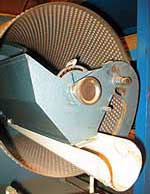Seed conditioning
Separating the
Good
from the Bad
The
journey from seed harvested from the field to a clean, uniform seed
lot with good vigor and germination characteristics can be a long
trip. Here are a few tools that seedsmen can use, when separating
the good from the bad.
General
The Cripen cleaner
(right), or something like it, has been around for at least 70
years. It uses air to separate the light material off and different
screens to separate the trash and weed seeds from the good seed.
Separating
Heavy Seed from Light Seed
 The
gravity table
(left)
uses both air and
gravity to separate the heavier seed from the lighter seed. Enough
air is blown through the perforations in the tabletop to lift the
lighter seed off the table.
The
gravity table
(left)
uses both air and
gravity to separate the heavier seed from the lighter seed. Enough
air is blown through the perforations in the tabletop to lift the
lighter seed off the table.
The table is
slanted downward, but vibrates upward so the heavier seed that still
has contact with the tabletop is moved upward and falls off the top
part of the table into a separate bin.
The light seed,
not having contact with the table, moves downward, by way of
gravity, and falls off the lower end of the table into its own
“light seed” bin.
 Separating
Seed by Color
Separating
Seed by Color
The color sorter
(right)
uses an
electronic eye that can pick up different colors according to the
way the machine is adjusted. As seed falls down a shoot, it passes
through the electric eye. If the color of the seed is different than
the desired color, the electric eye will activate a sudden burst of
air that pushes that seed into a reject bin while the rest of the
seed passes through to another bin.
Separating
Round Seed from Flat seeds
 Seed is poured
into this Spiral
(left).
The rounder shaped seed “rolls” to the outside of the spiral as it
goes downward, and then off the side of the spiral into a shoot to a
bin. The flatter seed does not “roll” as well and stays closer to
the center as it goes down the spiral. The flatter seed that stays
near the center of the spiral goes into a different shoot and a
separate bin.
Seed is poured
into this Spiral
(left).
The rounder shaped seed “rolls” to the outside of the spiral as it
goes downward, and then off the side of the spiral into a shoot to a
bin. The flatter seed does not “roll” as well and stays closer to
the center as it goes down the spiral. The flatter seed that stays
near the center of the spiral goes into a different shoot and a
separate bin.
 Separating
Big Seed from Little Seed
Separating
Big Seed from Little Seed
This indented cylinder (right) rotates as seed is poured into it.
Seed that fits into the “indent” inside the cylinder is carried up
and dropped into a separate compartment in the center, which leads
to one bin. The seed that is too big to fit into the “indent” stays
at the bottom of the cylinder and is funneled into a different bin.
There are many more ways in which a seedsman turns seed he harvests into seed
that a vegetable grower can plant with good results, but that’s all
the time we have for now.
I’m putting
together a new set of topics for the next newsletters. If you have
a topic that you would like me to report on, please drop me an email
(k.kubik@hmclause.com),
and I’ll try to include it in the next line-up.
Keith
k.kubik@hmclause.com